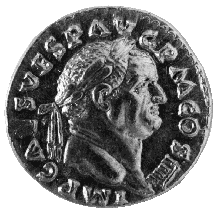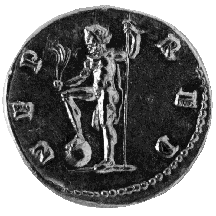



(83) Vespasian - AV aureus, A.D. 72, 6.32 g. (inv. 91.148).
Obverse: Laureate head of Vespasian r.; IMP(ERATOR) CAES(AR) VESP(ASIANVS)
AVG(VSTVS) P(ONTIFEX) M(AXIMVS) CO(N)S(VL) IIII: Imperator Caesar Vespasianus
Augustus, pontifex maximus, consul for the fourth time.
Reverse: Neptune l., nude but for cape, with r. foot on globe, acrostolium
in r., trident in l.; NEP(TVNVS) RED(VX): Neptune the Returner.
Provenance: Abner Kreisberg, 1971.
Bibliography: H. Mattingly and E.A. Sydenham, The Roman Imperial Coinage
II: Vespasian to Hadrian (London 1926) 46.
The most important military event in the reign of Vespasian was the capture
of Jerusalem by his son Titus in A.D. 70. Jerusalem had held out when Vespasian
himself had earlier subdued the rest of Judaea. The victory solidified Flavian
power in Rome, and in A.D. 71 the victory of Titus was turned into a joint
triumph for Vespasian and Titus. The triumph included a procession carrying
the spoils taken from the Temple in Jerusalem, an event later recorded on
reliefs on the Arch of Titus in Rome. The reverse of this aureus celebrates
the return of Titus from Jerusalem with a depiction of Neptune, god of the
sea, characterized in the coin's legend as the Returner. He holds his usual
attributes, a trident and an acrostolium or bow ornament of a ship.
The portrait on the obverse shows Vespasian's preference for realism, probably
an attempt to commend himself as a man of the people. He is depicted as
heavy-set and balding, with a lined face and neck and with the broad forehead,
hooked nose, and prominent chin that make his one of the most easily recognizable
imperial portraits.
C.L.L.



All contents copyright (c) 1996.
Lawrence University
All rights reserved.